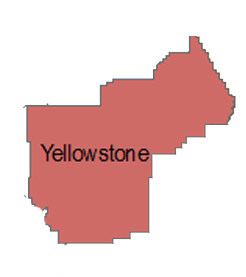In the counties…
Yellowstone County is Montana’s largest economic hub, made so in large part because it serves a four-state regional area. Partly because its economy is based upon success of other states in the region, which have had their own economic struggles, Yellowstone County’s economy has had a “subpar performance for the latter half of the previous decade,” explains economist Pat Barkey, Director of the Bureau of Business and Economic Research.
He referenced areas like the Bakken in North Dakota, whose gas and oil industry has a significant impact on Yellowstone County. Despite that, the county has had some steady improvement over the past two years because of improvement in some of its core industries, which includes “strong visitor spending.”
While Yellowstone County and Billings had strong growth in 2022 at 3.1 percent, Barkey said he is pessimistic about 2023 for the county – projecting a growth of less than zero at – 1.1 percent.
The county’s health care industry, has had “sluggish” growth, which has been the industry’s experience across the state.
Banking and finance, retail, wholesale and transportation-related businesses in Yellowstone County have been enjoying growth.
It was noted that, unlike other areas of the state, much of Yellowstone County’s population growth has been from other counties in the state.
Looking beyond 2023, the BBER forecast was quite a bit better with 2024 projected at 2.4 percent, and 2025 at 3.1 percent and 2026 at 2.0 percent.
Yellowstone County’s most prominent industry (wages as a share relative to US average) is Mining, followed by Wholesale Trade and Health Care, followed by Transportation and Construction.
Defying the law of supply and demand, the number of housing starts over the past two years has slipped, while median sales prices have increased. Housing has barely been able to keep on a par with the county’s population growth which has ranged from 11 percent to 14 percent over the past couple of years. In 1980 housing growth was 46.6 percent in the county while population growth was 23.7 percent.
Recovery in employment over pre-pandemic levels has been strong, with Accommodations and Food having seen phenomenal growth. Growth has also been strong in Construction, Transportation and Professional/ technical fields.
Airport passenger enplanements at Billings Logan International Field have not recovered from declines over the past three years from a peak in 2019.
The situation for other highly-populated areas of the state is varied.
GALLATIN COUNTY
Gallatin County has the state’s fastest growing economy, according to the BBER, noting that that growth is spreading across the county from Bozeman to impact Belgrade, Manhattan and Three Forks. Tourism has had a strong impact on the county’s economy, in more ways than one. While many of the businesses that serve the tourism industry have surged, many have been forced to limit their hours or expansion because of workforce issues. Not only is it difficult to find workers but the escalating cost of housing in Gallatin County makes it difficult for workers to be able to afford to live there.
Nevertheless, visitor spending is expected to remain strong in Gallatin County, which along with strong tech growth and its attraction for out-of-staters to relocate there, will continue to spur strong growth into coming years. While Gallatin County is attracting out-of-state migration, others are leaving the county to relocate in other Montana counties.
FLATHEAD COUNTY
Experiencing the second fastest growth in Montana is Flathead County, which in 2021 was almost as strong as Gallatin County. Driving the economy is visitor spending and construction. The BBER forecasted 2023 growth at 1.9 percent in non-farm earnings. Housing prices cooled in Flathead County in 2022, and wages surged by 20 percent. Its basic industries are non-resident travel, manufacturing, health care and government.
Flathead County is projected to experience 1.9 percent growth in 2023.
MISSOULA COUNTY
Visitor spending was also important to strong growth for Missoula County, which has had “noticeable acceleration” in its economic growth over the past two years. Visitor spending has spurred the expansion of the motel and restaurant business segments in Missoula. The county also has growth in tech industries and in health care.
While not quite as robust as in Flathead and Gallatin Counties, construction has been strong in Missoula, where 2023 growth has been projected at 1.5 percent.
SILVER BOW
After three years of negative growth, Silver Bow County experienced positive growth of 5.5 percent in 2021. In 2022 growth was 0.6 percent. Such volatility for the county is not unknown, said economist Pat Barkey, because of its exposure to world commodity prices. Mining is the county’s most predominant industry. Like so much of the rest of the state, the county benefited from non-resident spending.
Positive growth is not projected to continue into 2023, according to Barkey, who projects negative growth of -0.7 percent.
CASCADE
Cascade County has “upshifted” into faster growth, according to the BBER. In 2021 its growth was 3.3 percent—the fastest growth since 2006. Its growth has been spurred by new building construction in both residential and commercial projects. A new medical school is one example. Great Falls is a trade center for the agricultural “Golden Triangle” area.
Government and federal military are Cascade County’s biggest industries because of the presence of the military base. Health care follows as the next important business segment.
While the growth in 2022 was 2.1 percent for Cascade County, projected growth for 2023 drops to 0.3 percent.
LEWIS & CLARK COUNTY
Lewis & Clark County has seen unprecedented growth in federal transfer payments related to federal transfer payments for pandemic stimulus programs. As those programs wound down, the county’s growth decelerated in 2021 but still came in at 2.7 percent in 2022.
This county too benefited by visitor spending and had an uptick in retail trade. Government and state government are at the top of the most prominent industries in the county. The county is projected to experience 0.5 percent growth in 2023.


0 comments